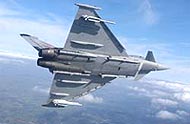Eurofighter Typhoon: Rafting out the moon
By Rajiv Singh | 22 Feb 2007
This is a problem for the engineers as the tolerances now used to build the Typhoon's airframe, and of similar advanced aircraft, are so fine that if the movements of tides is not accounted for in the manufacturing process, it could result in throwing a jet fighter's tolerances out.
 According to Martin Topping, Typhoon's final assembly operations manager: "Every time the moon pulls the tide in and out, the ground under our feet actually moves by between one and two millimetres. That might not sound a lot, but given the tolerances we are working to on Typhoon, two millimetres is two millimetres too much."
According to Martin Topping, Typhoon's final assembly operations manager: "Every time the moon pulls the tide in and out, the ground under our feet actually moves by between one and two millimetres. That might not sound a lot, but given the tolerances we are working to on Typhoon, two millimetres is two millimetres too much."
BAE Systems has addressed the problem partly by putting in special automated alignment facilities, which use laser-trackers and computer-automated jacks. The company's main effort, however, has gone into building giant 'floating' concrete rafts on which the aircraft and measuring equipment sit. These rafts actually ensure that each Typhoon's airframe is built as close to perfection as is humanly possible.
"Each of these concrete rafts is over three metres deep and 18 metres long," says Martin. "All 9 automated jacks and both laser trackers are positioned on one surface ensuring all movement is relative, achieving a near perfect alignment whatever the moon may be doing." BAE Systems has spent over £2.5million in the design and installation of these systems.
The result, according to BAE Systems, is one of the most perfectly aligned jet airframes in the world. Every Typhoon that leaves the BAE Systems plant in Warton varies from the true by no more than the thickness of a matchstick. The unstable, but hugely agile, Typhoon is 15 metres long, tip to tip, and such build accuracy helps the Typhoon's fly-by-wire computer system to accurately control the aircraft.
Thanks to such build accuracy there is a minimal need to 'trim' the flying surfaces, allowing pilots to make maximum use of the aircraft's flying potential.
Pioneered on the Typhoon, this advanced manufacturing technology is now being utilised for the manufacture of the US F-35 Lightning II, slated to be the world's first stealthy, supersonic, multi-role fighter.






















